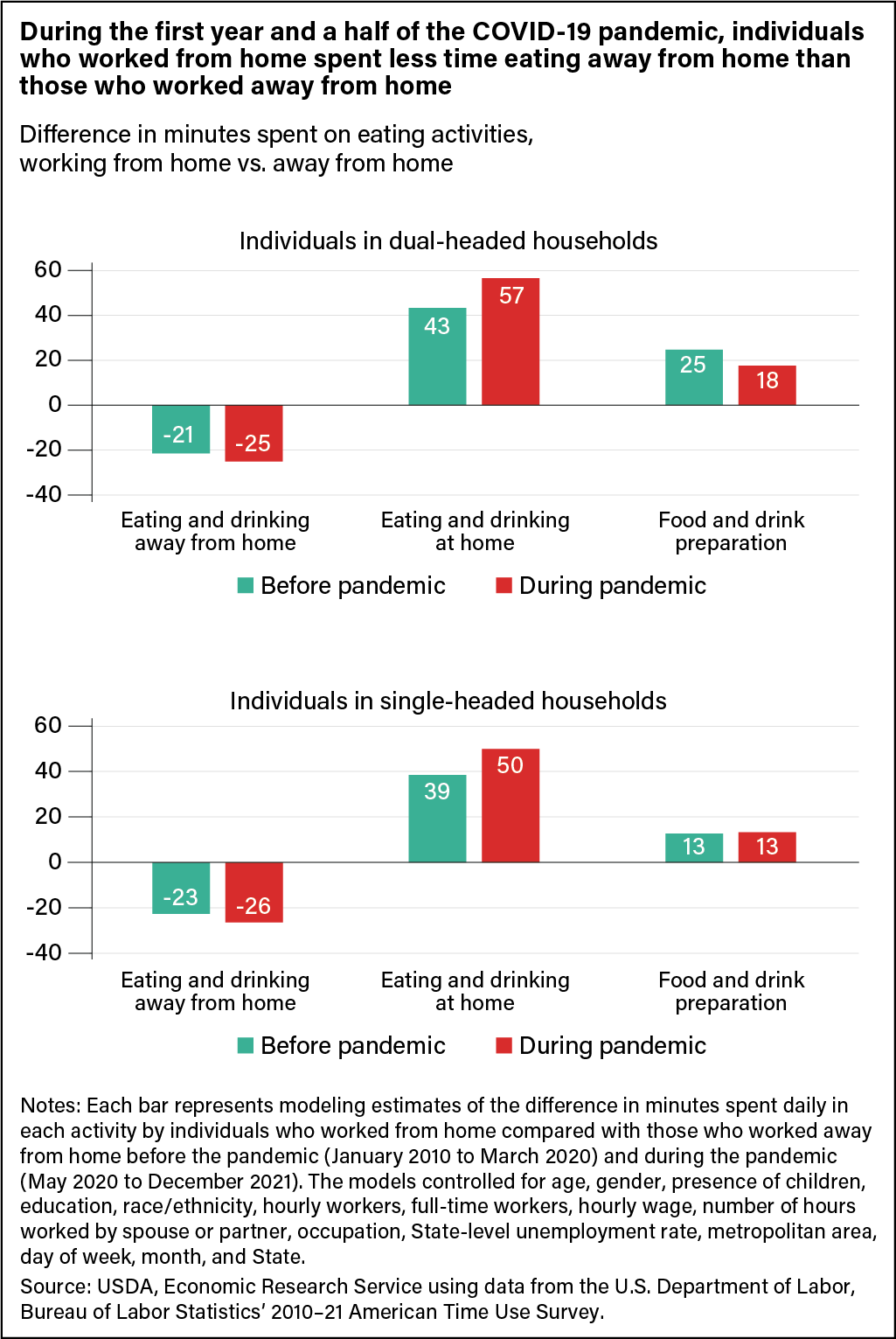
People Working From Home During the Pandemic Spent Less Time Eating Away From Home
- by Eliana Zeballos and Brandon J. Restrepo
- 10/26/2022
The emergence and spread of Coronavirus (COVID-19) in the United States in early 2020 was quickly followed by social-distancing guidelines and stay-at-home orders. As a result, many people worked from home during the first year of the COVID-19 pandemic, resulting in changes to their daily schedules. In a recent study, USDA, Economic Research Service (ERS) researchers used 24-hour time diary data from the Bureau of Labor Statistics’ 2010–20 American Time Use Survey (ATUS) to examine how daily time allocations of individuals who worked from home changed during the pandemic compared with those who worked away from home. ATUS data through 2021 are now publicly available and have been added to the 2010–20 data set that is discussed in this article.
In the decade before the pandemic—from January 2010 to March 2020—individuals in dual-headed households (with a partner or spouse) who worked from home ate out less and ate at home more than those who worked away from home. During that period, individuals in dual-headed households who worked from home spent a daily average of 21 fewer minutes eating away from home than individuals who worked away from home. At the same time, they spent 25 more minutes preparing food and 43 more minutes eating at home. Individuals in single-headed households who worked from home also spent less time eating away from home (23 fewer minutes), more time preparing food (13 more minutes), and more time eating at home (39 more minutes) than those who worked away from home.
During the pandemic, these differences in time allocations mostly increased. From May 2020 to December 2021, people who worked from home spent even less time eating away from home (a daily average of 25 fewer minutes among dual-headed households and 26 minutes among single-headed households) than those who worked away from home. The difference in the amount of time spent eating at home also increased. Individuals in dual-headed households who worked from home spent 57 more minutes eating at home than those who worked away from home. For single-headed households, the intra-pandemic difference grew to 50 minutes for eating at home. However, the difference in the amount of time preparing food shrank (18 vs. 25 minutes) for dual-headed households and stayed the same at 13 minutes for single-headed households.
The smaller amount of time devoted to eating away from home during the first year and a half of the pandemic may have been partly driven by closures or reduced operating hours at food-service establishments and efforts at social distancing to avoid transmitting or contracting COVID. This result is in line with findings from ERS’s Food Expenditure Series that show food spending at food-away-from-home establishments decreased from 2019 to 2020. The reduction in time spent eating away from home during the pandemic may also be one of the most notable changes during the pandemic of daily time allocation with possible implications for the diet-related health outcomes for individuals who work from home. A large body of research, including this 2010 ERS report, has shown that eating food prepared away from home tends to result in higher calorie intake and possibly affects diet quality. However, the dietary implications of the reduced time eating away from home are unclear without data on the types and quantities of foods eaten by the ATUS survey respondents.
This article is drawn from:
- Restrepo, B.J. & Zeballos, E. (2022). “Work from home and daily time allocations: evidence from the coronavirus pandemic”. Review of Economics of the Household. doi: https://doi.org/10.1007/s11150-022-09614-w.
You may also like:
- Zeballos , E. & Sinclair, W. (2021, October 4). Food Spending by U.S. Consumers Fell Almost 8 Percent in 2020. Amber Waves, U.S. Department of Agriculture, Economic Research Service.
- Food Expenditure Series. (n.d.). U.S. Department of Agriculture, Economic Research Service.
- Zeballos , E. & Restrepo, B.J. (2021, February 1). Working From Home Leads to More Time Spent Preparing Food, Eating at Home. Amber Waves, U.S. Department of Agriculture, Economic Research Service.
- Restrepo, B.J. & Zeballos, E. (2020). “The effect of working from home on major time allocations with a focus on food-related activities,”. Review of Economics of the Household. doi: https://doi.org/10.1007/s11150-020-09497-9.


